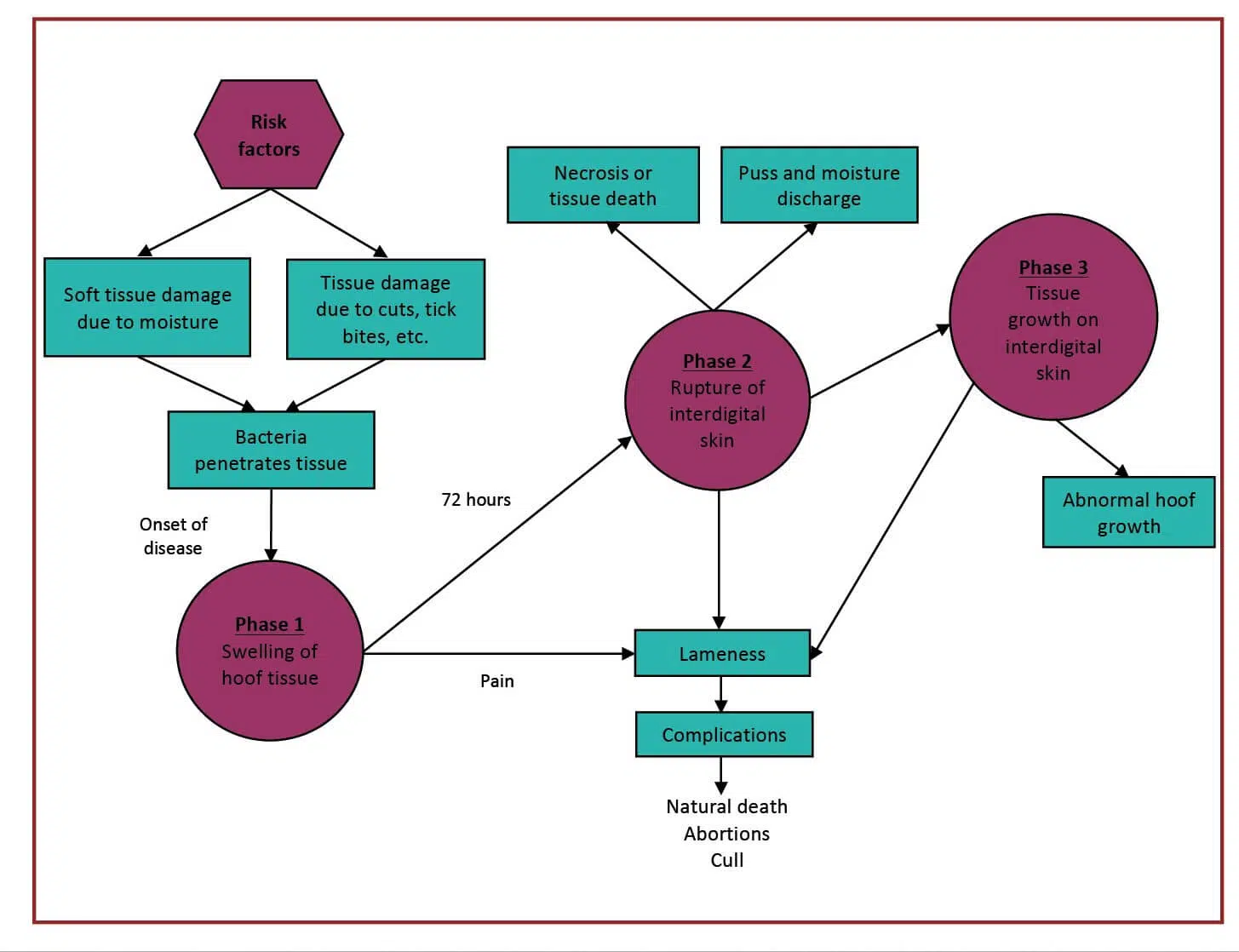Although there are many reasons as to why sheep develop hoof problems, foot rot is certainly the foulest of all. A highly contagious bacterium, Dichelobacter nodosus, is responsible for these infections.
If an animal has soft hooves due to moisture or has sores on its hooves and on the tissue surrounding the hooves due to tick bites, cuts, or tears, bacteria can easily enter the tissue. The disease then progresses through three phases, each with its own consequences (Figure 1):
- Phase 1: The foot begins to swell, causing pain and lameness.
- Phase 2: The interdigital skin starts to rupture.
- Phase 3: Abnormal tissue growth occurs on the interdigital skin.
Discomfort in the animal already becomes noticeable during Phase 1. The first thought that usually comes to mind is that the animal may have been hurt and, as a result, the producer often waits a day or two to see what happens. Unfortunately, it is exactly this waiting period that allows the disease to progress to Phase 2 – and this is when the real problems start. The animal experiences extreme discomfort and requires aggressive treatment to recover.

Treating foot rot
Treatment involves cutting away the affected areas on the hooves, after which the animal has to stand in a disinfecting foot bath. Disinfectants such as zinc sulfate or formalin are commonly used, and the hooves must remain in contact with the disinfectant for at least two minutes. This step must be repeated daily until significant progress has been made.
The use of antibiotics and pain medication is also prescribed during this period. The herd veterinarian will assist in deciding which agents to use. If there is no progress, the animal will have to be culled, thereby contributing to unnecessary on-farm expenses.
Preventive management is key
Ultimately, prevention remains better than cure. The following steps can be followed to prevent foot rot:
- Only buy animals from reputable breeders and quarantine bought-in animals for at least 30 days.
- Avoid wet and muddy pens. Animals should preferably have a dry place to stand and sleep in.
- Treat wet pens with agricultural lime. The bacteria cannot survive in an alkaline environment.
- Quarantine affected sheep for at least 30 days until they have recovered.
- Make sure animals ingest enough vitamins and minerals. Minerals such as zinc and copper are crucial for hoof health and promoting a strong immune system, helping the animal to fight bacteria.
- Hooves must be trimmed regularly and kept in good condition.
- As part of a prevention programme, let animals walk through a foot bath on a regular basis. The suggested minimum is every 30 days.
Livestock producers need to realise that eradicating and managing foot rot is hard work that involves a long-term process, but success is possible if a healthy prevention programme is followed.
Managing foot rot has financial benefits and is also beneficial for animal welfare. Healthy animals can produce optimally and generate money. The biggest goal is therefore to keep your animals healthy and happy.
You can also read more about foot rot in sheep and goats in this article by Lynn Pezzanite, Dr Mike Neary, and Terry Hutchens as published in Common Diseases and Health Problems in Sheep and Goats (AS-595-W) by Purdue Extension.
Anri Strauss is a scientific adviser in the ruminant team at Chemuniqué, holding a master’s degree in nutrition from the University of Pretoria. She grew up on a farm and still lives in the Free State, where she and her husband also farm with Boer goats.










